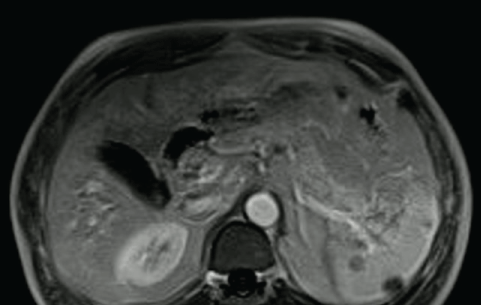A 53-year-old man, with history of paranoid schizophrenia, depression, alcohol abuse, type 2 diabetes mellitus, comes to our observation for the discovery of focal splenic lesions. He presented fatigue and weight loss. Her past clinical history was negative for infection, abdominal pain, fever or sweat. Physical examination was characterized by cachexia in the absence of lymphadenomegaly and hepatosplenomegaly. Laboratory tests were negative, except for the C. burnetii antibodies (phase I IgG 1/128, phase II IgG 1/400 and negative IgM). Biological liver and kidney function were normal. Hepatitis B, hepatitis C, HIV, EBV, CMV serology were negatives. Positron emission tomography (PET) showed more hypermetabolic splenic lesions, distal small intestine hypercaptation associated with mesenteric lymph nodes and a right sub-clavicular lymph node (Figure 1). The splenic lesions had been confirmed by abdominal magnetic resonance imaging (MRI) (Figure 2). Colonoscopy showed inflammatory polipoyd lesions of the distal small intestine and uncomplicated diverticular colic disease. Gastroscopy, pulmonary scan, transesophageal echocardiography and bone marrow biopsy showed negatives. Doxycycline 200 mg b.i.d. and rifampicine 600 mg daily for three months treatment was initiated. In the absence of any improvement, after adequate vaccination for meningococcus, pneumococcus and haemophilus, splenectomy was carried out. The histopathological examination highlighted diffuse granulomatous process with multinucleated cells, mononuclear infiltrates, necrosis and fibrinous exudation. Coxiella burnetii DNA was negative in PCR.
The general incidence of Q fever is actually underestimated, owing to diagnostic difficulties, polymorphic clinical presentation and high prevalence of asymptomatic cases. In fact, 60% of the affected patients remains asymptomatic, while 40% develops an acute Q fever, which could be a self-limiting flu-like syndrome, hepatitis, pneumonia or meningo-encephalitis. In 5% of patients, months to years following the primary infection, the bacterium leads the development of a chronic Q fever, which raised insidiously and can lead to endocarditis (60%), aneurysm or vascular prostheses infections (20%) and some other manifestations less frequent, such as osteoarticular (7%), lymphadenitis (6%), genital infections (3%), pericarditis and hepatic disease [1,2].
In conclusion, we described an unusually case of chronic Q fever, original for presentation with splenic isolated involvement. In literature cases of splenic infarction [3] and mycotic splenic artery aneurysm [4] are described, but no abscesses as splenic focal lesions. In the presence of splenic focal lesions, the diagnosis of Q fever should be excluded. Differential diagnosis with a non-Hodgkin lymphoma should be considered [5]. A prolonged antibiotic treatment at 18 months is necessary.

Figure 1: Positron emission tomography with hypermetabolic splenic lesions.

Figure 2: a,b) Confirmed splenic lesions by abdominal magnetic resonance imaging.